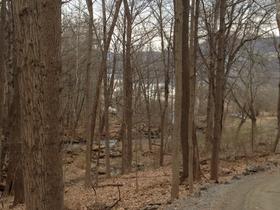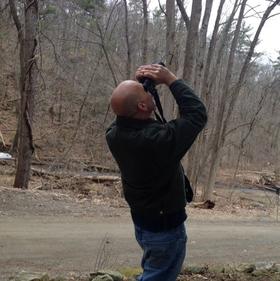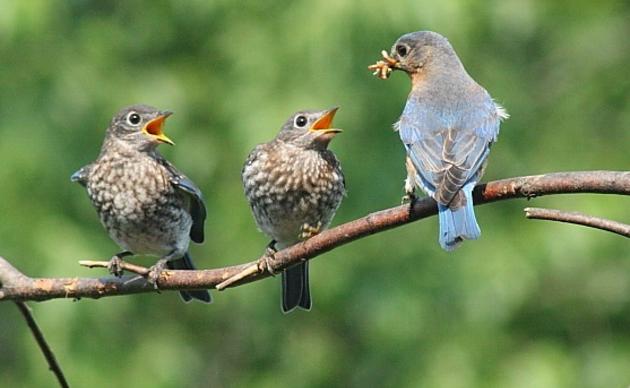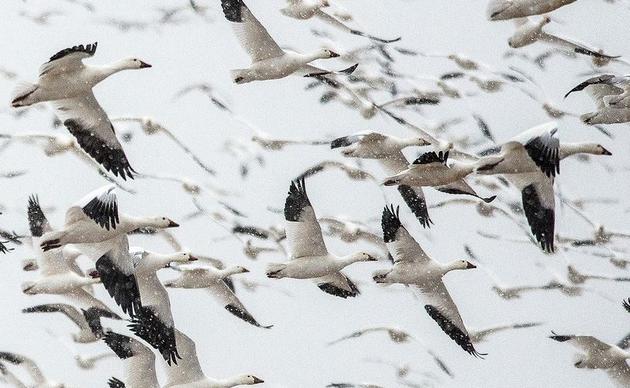Original story and radio clip on WAMC Northeast Public Radio by Allison Dunne
April 10, 2015
Spring is attempting a full-on arrival. Flowers stems are pushing through the earth and April showers, even if they have been mixing with snow in parts, are frequent. Another sign of spring is birdsong.
Sure, the red robin is a harbinger of spring, but for me, the telltale sign is the house finch. One pair began occupying a ledge under the rooftop near my bedroom window nearly a decade ago. Now, every year around this time, the finches are well into their ritual. After a few years, I grew curious about the life of this pair. First, there’s the nest-building stage replete with an astounding work ethic. I had to know more, so I ambled over to the Constitution Marsh Audubon Center and Sanctuary in Garrison where lifelong Hudson Valley resident Eric Lind is the director. Before I have the chance to barrage him with my finch questions…
“What would you say, in the last 30 seconds there’s an eagle, a belted kingfisher, and then two wood ducks, and then out in the cove here there’s buffleheads and hooded mergansers,” says Lind. “And I don’t know if you can hear it, but that loud, cheerful sound is a cardinal.”
After that ornithological review, I learn that the finches have not returned from some tropical paradise. Rather, they spent the winter not terribly far from my house, perhaps just a state or two south, if that. They’re not, as Lind puts it, long-distance migrants. In fact, they’re not even native to the East Coast.
“The thing about house finches, which is really interesting, is in the East Coast you wouldn’t have seen them before 1940 or so. So the story is is that they’re native to the West Coast, the other side of the continental divide, but they were popular caged birds,” Lind says. “And there’s a really interesting story that in Brooklyn, I think, if I remember right, a shopkeeper had house finches in a cage and he released them. And they established, they became naturalized to the East Coast.”
So my house finches are descendants of the West Coast via Brooklyn? I checked it out. One source mentions the West Coast via Long Island. Either way, it wasn’t Central America. OK. Not the story I was expecting but I’m clinging to the part that they were caged birds. I then wanted to know if the finch pair was the same pair that returns year after year.“It’s impossible to really know if they are the same individual birds that you have seen in previous years, but it’s possible and, in fact, probable because they found a good nesting location,” says Lind. “And if they were successfully hatched last year, they’ll come back.”
I feel my connection to the finches deepen, until I ask another question.
“What is their life span?”
“Small birds like that usually only live a few years, 4 or 5 years, something like that,” Lind replies.
So much for the same pair having returned for nearly a decade. Lind offers immediate comfort by telling me that if the finches found their accommodations to their liking, the offspring may very well return. So it could still be all in the family outside my window. Plus, the Cornell Lab of Ornithology says the oldest known house finch was 11 years, 7 months.
For Lind, the spring harbinger is the phoebe. In fact, there is a phoebe nest cam at the center.
“When I hear them, I really, really feel like, yeah, spring is here. And there’s hundreds of other examples,” says Lind. “The brook down here, in the next couple of weeks, there’s a small songbird called a Louisiana water thrush. They’re on their way back now from Venezuela or someplace like that. And in the next couple of weeks they’ll be back here and this is their preferred breeding habitat.”
For the birds flying in, near or far, there is a driving factor.
“So the spring migration, they are on a mission,” Lind says. “They have one thing on their mind and that’s to get back up here and breed and reproduce.”
I can attest to that on behalf of the finches residing near my window. Once they’ve made their bed, they do lie in it. After the female lays her eggs, the nest guarding begins. One parent keeps watch from the deck, just a 2 second flight from the nest. Some two weeks later, a higher-pitched chorus erupts. The parenting begins, including heading into the backyard wilderness for groceries. Eventually, the chicks try their wings, making it first to the deck, then to the nearest juniper bush. Before I know it, they’re gone, all of them. It is literally empty nest syndrome, which, according to Lind, is not my only affliction.
“There is a famous ecologist, E.O. Wilson, who tried to define all of this that we’re discussing. And he put a term to it. It’s called biophilia,” says Lind. “And basically it’s a curiosity and love of other living things. And that’s what you’re expressing. We’re afflicted with a love of the living world.”
After the diagnosis, Lind insists we take our eyes from the skies and look down.
“This is another migration that’s happening now that we have to discuss since we’re right here on the river shoreline,” says Lind. “At this time of year, there are pulses of different fish species that are coming out of the coastal Atlantic and migrating up the river. And some will come even into these small tributaries just to spawn and to lay their eggs and reproduce.”
It’s that driving force again.
“There’s spottail shiners. There’s yellow perch and white suckers that have this much less famous migration like the shad or salmon or something like that,” Lind says. “But they utilize the tributaries to complete their life cycle.”
Back to the finches. In recent years, it seems word has gotten out about the prime nesting site at my house. I now have two, sometimes three, nesting pairs lined up on the ledge. In fact, the site is so popular that other species fly in once the finches leave, as if the finches have made subletting arrangements. Lind has given my whole finch experience context. I’ll now look for the phoebes, walk down to the brook to spot glass eels, and keep watch near the Hudson River for others that fly or swim into my life, albeit briefly.






